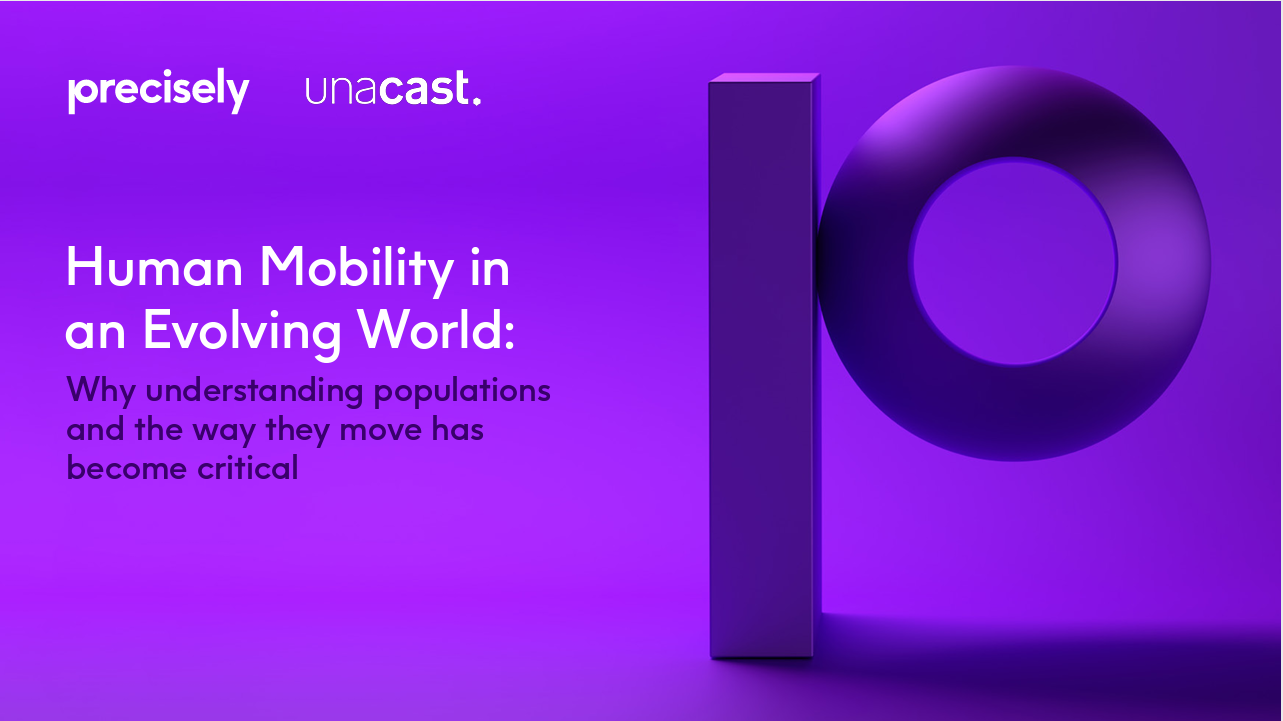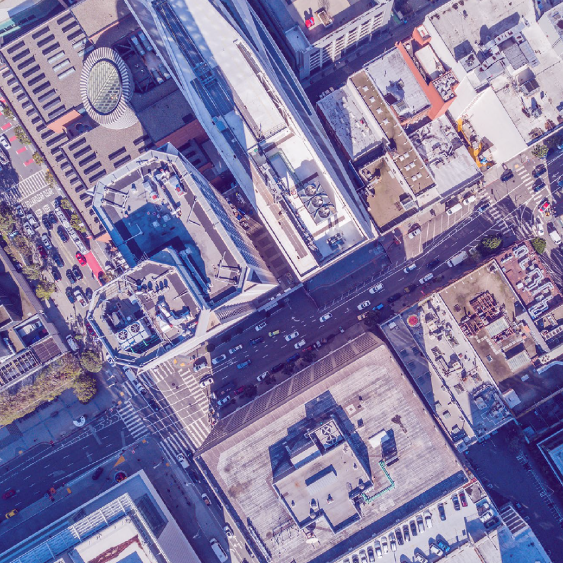eBook
Human Mobility in an Evolving World: Why understanding populations and the way they move has become critical
Over the last decade, how and where people migrate and move has evolved significantly. Human mobility data, or anonymized, aggregated information about how people move based on their cellular network locations, helps corporations and government entities discover population patterns at a granular level.
During the COVID-19 pandemic, human mobility data became more important than ever before as it was used to predict and illustrate to the public how infectious disease spreads and how it could be stopped. However, even before COVID, public health researchers were already leveraging mobility data to create risk maps that help policymakers and healthcare workers reduce the threat of disease in high-risk parts of the world. Governments and policymakers have also been using mobility data for healthcare and public works planning for years. The ability to see mobility data that goes far beyond census data is helpful for making decisions about public works projects such as parks and recreation facilities, commercial and residential real estate development, city planning, and more.
Today, there is increased interest in mobility data from both the public and private sectors. For example, mobility data gathered from enabled smartphone apps has revealed how COVID altered movement patterns, both temporarily and long-term. As organizations navigate an ever-changing global landscape, they’re looking to human mobility data to help them make better strategic decisions for the future.


Drivers for change: eCommerce, ridesharing, & remote work
Human mobility has been evolving for years, but there are a few key drivers in recent rapid changes: eCommerce, ridesharing, increased remote working, and the COVID-19 pandemic.
The growth of eCommerce and the expanding availability of home delivery has changed where and how people shop. An increase in accessible, affordable grocery and essentials delivery means some consumers only go to stores in person to buy specific things. As a result, malls, High Streets, Main Streets, or areas with dense concentrations of retailers have changed; today, there are fewer retail outlets and more coffee shops, boutique fitness studios, restaurants, and social gathering spaces.
Ridesharing and ride-hailing apps and services such as Uber and Lyft have also changed human mobility by giving people more options for where they can go. For example, when making vacation or weekend plans, ridesharing services allow consumers to go other places than they could have when their only option was walking or public transportation. As such, ridesharing services haven’t replaced taxis, they’ve increased the market, and in this case, the distance people can travel for work and leisure.
Remote working, which has been expanding for years, was drastically accelerated by the COVID pandemic almost overnight. Many corporations found they can save money – and lure in-demand employees – by fostering a culture of remote work, while others will require employees to return to an office. The vast number of workers who will never, or rarely, return to an office building is already causing a massive shift in migration patterns and mobility trends. Employees who work from home won’t go out for lunch or coffee or run errands at lunchtime, in the same way they had before. The added flexibility in remote work has also caused people to move to different cities and towns, leading to a rapid change in the demographic makeup of many places.
Best practices for gathering data and protecting privacy
Human mobility reflects changes in society by revealing how people migrate and move along systems or networks. As the human mobility field of study evolves, privacy is paramount. Human mobility data must be gathered from providers in a way that is compliant with all privacy rules and regulations and only with the consumer’s permission.
Data should be gathered through real-time data sources such as aggregated, anonymized mobile phone records shared within the parameters users set within a mobile phone app. Using data users share via apps on their mobile phones is safe and private because no data aggregator can see or track one device, and no device is available 100% of the time. For example, depending on the user and the app, a device may share information for 10 minutes every couple of days or a few hours every day. Information is collected based on GPS rather than triangulated mast locations, which helps protect individual privacy. By contrast, information shared to a mast location, such as a cell phone tower, is always private and only available to cellular network providers.
The fundamental nature of sharing and gathering location data will always require discussion and debate, but working within a framework that promotes fairness and protects individual privacy, aggregated human mobility data can improve health and services for everyone.


Leveraging human mobility data
With growing interest in understanding how people migrate, enterprises across sectors are leveraging human mobility data to make better decisions and adapt to a rapidly changing world. A consumer goods retailer might use human mobility data to determine what types of products to stock and store locations to focus on. In the past, sales data was helpful making these decisions, but it couldn’t reveal anything else, such as how many people walk by your store and their demographic profile.
As another example, one of the pandemic’s most disruptive changes was in the commercial real estate industry. Human mobility data can be used to reasonably predict who’s coming back to work at a physical location and who isn’t, or which clients might not renew their leases when they’re up. Mobility data related to the weekday influx of commuters is also essential for retailers, restaurants, and other businesses that depend on office worker traffic.
For the tourism sector, human mobility data can reveal and predict travel behavior, allowing businesses in the industry to develop strategies to adjust to or accommodate changes in how and where people spend their leisure time. It can also enable targeted campaigns that share helpful information to specific consumers and inform business and civic plans for strategic growth.
In the public sector, researchers and officials can use mobility data to predict and manage outbreaks of infectious diseases. Mobility data can also be used to inform decisions about large infrastructure projects that support a growing or fluctuating population.
For large enterprises, location data plays a critical role in strategic planning. Aggregated location data can illustrate how many people live or work in a given region or meet in certain areas. Beyond strategic planning, organizations can use location data for forecasting, supply chain, and logistics planning, assessing their commercial portfolios, identifying gaps in the serviceable market, understanding shifts in demographics in their customer base, and understanding key points of interest and trends in destination visits.
Challenges working with movement data
While there is value to be unlocked in human mobility data, working with it is a complex and challenging undertaking. Adding spatial and time dimensions to data analysis multiplies complexity in a process that is already difficult and time-consuming.
Aggregating data isn’t straightforward, and it’s vital to understand meaningful sample sizes in terms of space and time. With raw mobility data, you only get a small sample – from 5% to 10% – of the devices in an area at a time. If you don’t aggregate enough data over a broad area or timeframe, it’s easy to build bias into decision-making.
Not only is data complicated to work with, maintaining individual privacy is of the utmost importance. However, not all vendors are diligent at maintaining privacy, which could cause significant disruptions for businesses using what they believe to be anonymized data.
For individual organizations, adapting and adhering to the ever-changing privacy regulations of various companies and countries can be prohibitive. Also, specific locations, such as schools and churches, should be considered sensitive places and should be protected so data isn’t abused.


Dynamic Demographics: Mobility + Demographics
Incorporating human mobility data into analytics provides the necessary granularity for organizations to get a clear picture of consumer activity. Dynamic Demographics is a new product in the Precisely Demographics family that helps businesses understand customers, neighborhoods, and destinations. Dynamic Demographics offers businesses dynamic population profiles at specific locations using sourced mobile location data combined with existing demographic data.
The combined dataset fills the gaps present in each; mobility data lacks demographic detail, and demographic data lacks the concept of movement. Precisely’s demographic data provides a deep and highly performing dataset; however, it only describes nighttime or residential populations. By folding in mobility data, Dynamic Demographics provides deeply enriched population movement patterns.
The data used in Dynamic Demographics shows how and when populations move from location A to location B. Data is aggregated to a geographic level, such as a neighborhood, statistical geography, or artificial geography such as a hex or grid. It is also aggregated across time, which illustrates habitual behaviors of populations, and the mobility data needed for decision-making.
By combining mobile location data with Precisely demographic data, we’ve created spatio-temporal dynamic datasets that unlock the value in data and enable strategic decision making. Because we know the nighttime location of devices, we can associate relevant local demographics, such as wealth or spend. Mobile location data then describes the devices as they move, and the tagged data at the destinations they visit can be re-aggregated with other device data from different origins, producing a new location file. This location profile can be created for any day of the week or any time of day.
Dynamic Demographics data from Precisely is compliant with all local privacy regulations, including GDPR, and only uses data collected from devices where the consumer has consented to collection for these purposes. Precisely doesn’t have, or sell, information related to individual devices.
Powerful New Insights Based on Dynamic Demographics
By combining dynamic mobility data with demographic data, Precisely further expands data utility and speaks to more use cases, giving organizations invaluable insights into the products and services they may deliver to specific locations. Use cases include:
Retailers and Financial Services
Retailers and financial institutions continuously analyze store and branch performance to identify new locations, ensure they have stores in suitable locations, and consolidate or adjust product offerings to meet changing demands. Dynamic Demographics provides invaluable insight to support these decisions by illuminating key characteristics of a location, including:
- the popularity of a location and how it changes over time;
- if a location has the necessary footfall to support a proposition;
- the demographic composition of visitors and how it changes over time, and how this impacts performance, service options, and hours of operation;
- if a location attracts the types of people who consume the specific products and services a retailer offers
Dynamic Demographics also assists in driving marketing activities by identifying the areas from which visitors are attracted and whether they are attracted by leisure or business.
Telco
Telecommunications organizations are always looking for ways to improve their services and tap into new market demand. Dynamic Demographics helps providers synthesize their data and identify opportunities for expanding coverage based on knowledge of the types of people present in locations where they currently have poor or low coverage.
Insurance
Insurance companies must understand risk from a variety of angles. Dynamic Demographics can overlay significant intelligence onto risks posed to physical assets insurance companies have within their book of business. This may be as simple as understanding the popularity of a location and the impact on claims, and therefore policy price, against companies associated with health and safety incidences. Insurance companies can also analyze more complex risks associated with popular locations and the types of people that dwell in those locations, which may relate to vandalism, fire, and attacks.
Marketing
Dynamic Demographics supports many marketing and advertising use cases, including out-of-home advertising. It can help identify the types of people who will see digital billboards at different times, adverts that should be displayed, and the measures of performance for that advertising. Dynamic Demographics can also help companies understand where consumers visit and dwell and where they originate from, driving location-based marketing to raise awareness, driving overall footfall, or promoting specific events.
Real Estate
Dynamic Demographics supports many use cases in both commercial and residential real estate. It helps commercial agents understand commercial property value through popularity, types of people, and where they originate. This allows them to target the right occupiers and support pricing. Residential real estate can use Dynamic Demographics to help customers understand neighborhoods and identify popular locations, what types of people they can expect to be in the community, whether it’s a quiet or busy neighborhood, and other critical factors. This helps consumers filter locations on the characteristics they want in where they choose to live.

Conclusion
Though human movement patterns have been evolving for decades, recent developments and events have accelerated changes. Analyzing human mobility data is a powerful way to discover how the evolving world and specific events, such as the COVID-19 pandemic, can temporarily and permanently alter human movement patterns. Dynamic Demographics from Precisely reveals daily, changing population characteristics and flows to help businesses make more accurate business decisions based on the types of people at locations at different times and days of the week.
Precisely & Unacast: Better Together
Precisely has extensive experience in location, location analytics, and location context data, working with leading organizations in insurance, retail, financial services, telco, and high tech to apply location intelligence to critical business processes. Unacast is a leading provider of location data, with deep expertise in handling, processing, and managing large datasets while ensuring quality, compliant data. Dynamic Demographics data from Precisely brings together these leaders in the field to deliver a unique and differentiated offering to market.